- Home
- About
- Map
- Trips
- Bringing Boat West
- Migration West
- Solo Motorcycle Ride
- Final Family XC Trip
- Colorado Rockies
- Graduates' XC Trip
- Yosemite & Nevada
- Colorado & Utah
- Best of Utah
- Southern Loop
- Pacific Northwest
- Northern Loop
- Los Angeles to NYC
- East Coast Trips
- Martha's Vineyard
- 1 Week in Quebec
- Southeast Coast
- NH Backpacking
- Martha's Vineyard
- Canadian Maritimes
- Ocracoke Island
- Edisto Island
- First Landing '02
- Hunting Island '02
- Stowe in Winter
- Hunting Island '01
- Lake Placid
- Chesapeake
- Provincetown
- Hunting Island '00
- Acadia in Winter
- Boston Suburbs
- Niagara Falls
- First Landing '99
- Cape Hatteras
- West Coast Trips
- Burning Man
- Utah Off-Roading
- Maui
- Mojave 4WD Course
- Colorado River Rafting
- Bishop & Death Valley
- Kauai
- Yosemite Fall
- Utah Off-Road
- Lost Coast
- Yosemite Valley
- Arizona and New Mexico
- Pescadero & Capitola
- Bishop & Death Valley
- San Diego, Anza Borrego, Joshua Tree
- Carmel
- Death Valley in Fall
- Yosemite in the Fall
- Pacific Northwest
- Utah Off-Roading
- Southern CA Deserts
- Yosemite & Covid
- Lake Powell Covid
- Eastern Sierra & Covid
- Bishop & Death Valley
- Central & SE Oregon
- Mojave Road
- Eastern Sierra
- Trinity Alps
- Tuolumne Meadows
- Lake Powell Boating
- Eastern Sierra
- Yosemite Winter
- Hawaii
- 4WD Eastern Sierra
- 4WD Death Valley +
- Southern CA Deserts
- Christmas in Tahoe
- Yosemite & Pinnacles
- Totality
- Yosemite & Sierra
- Yosemite Christmas
- Yosemite, San Diego
- Yosemite & North CA
- Seattle to Sierra
- Southwest Deserts
- Yosemite & Sierra
- Pacific Northwest
- Yosemite & South CA
- Pacific Northwest
- Northern California
- Southern Alaska
- Vancouver Island
- International Trips
- Index
- Tips
- Books
- Photos/Videos
- Search
- Contact
Bilbao, Spain
Friday, June 7, 2019 - 9:30am by Lolo
116 miles and 2.5 hours from our last stop - 1 night stay
Travelogue
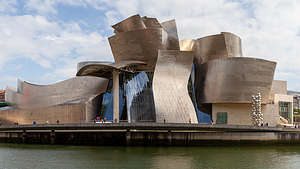 Bilbao Guggenheim MuseumOne of my favorite parts of travel is variety and the contrast of wildly different experiences. Today would be just that, as we started our day in the pristine natural beauty of the Picos de Europa and would end it in an old industrial city, also with plenty of beauty, but of the man-made kind.
Bilbao Guggenheim MuseumOne of my favorite parts of travel is variety and the contrast of wildly different experiences. Today would be just that, as we started our day in the pristine natural beauty of the Picos de Europa and would end it in an old industrial city, also with plenty of beauty, but of the man-made kind.
The drive to Bilbao was about 2 ½ hours, much of it a repeat of our side trip to Santillana del Mar. We were in a bit of a hurry as we wanted to secure a spot for the night in an Aires, called the Area de Autocaravanas de Kobetamendi, located in Bilbao. Otherwise, there really wasn’t much of an alternative as there are no commercial campgrounds in, or even near, the city.
As I mentioned in my overview, Aires are inexpensive (often free) places where overnight parking for camper vans is permitted. Most of them providing electricity, water fill, and waste disposal. Almost every city, large or small, has one located in either walking distance or near a bus stop to the major attractions of that city.
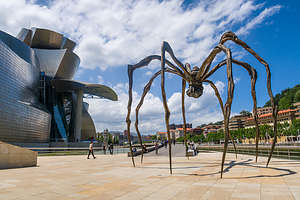 "Maman," the 30-foot spiderThe one in Bilbao was supposed to be one of the better ones in that it had a wonderful panoramic view overlooking the city and was located very close to a bus stop. It cost 15€ per night and included electricity and WiFi.
"Maman," the 30-foot spiderThe one in Bilbao was supposed to be one of the better ones in that it had a wonderful panoramic view overlooking the city and was located very close to a bus stop. It cost 15€ per night and included electricity and WiFi.
We got there by 11 am, about the time when people were leaving, so we had no trouble getting a spot, and it was a good one in that we had a great panoramic view out over the city. We could even see a little bit of the Guggenheim museum.
Another wonderful amenity in this Aires is that they had warm fresh bread every morning - something which I forgot to mention is a staple of every campground in Spain. Pretty much every morning of our trip so far, the first sight I would see when I woke up and looked out the window were men in bathrobes carrying baguettes.
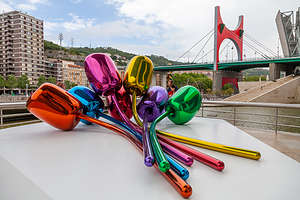 Jeff Koons’ giant roof-top “Tulips”But I digress. Back to the fascinating city of Bilbao.
Jeff Koons’ giant roof-top “Tulips”But I digress. Back to the fascinating city of Bilbao.
After a lunch of sandwiches on our fresh Aires’ bread, we walked the short distance down the hill to the bus stop which would bring us to the Nervión River, along which we could walk about a mile to the Guggenheim Museum. We got to see a bit of the non-touristy part of the city during our bus drive, and it was quite a contrast to the cities we had been to so far - much grittier, poorer, and more industrial. Plus, we were in Basque country now, so the language was different than the Spanish we had heard in the rest of the country - lots of x’s and k’s.
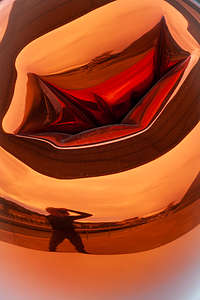 "Tulip" reflectionsThe walk along the river was nice, and there was much activity as people were setting up for the World Stand Up Paddleboard Challenge, which was to start the following day. As a result, there were lots of paddle boarders in the river practicing or just goofing off before the big day.
"Tulip" reflectionsThe walk along the river was nice, and there was much activity as people were setting up for the World Stand Up Paddleboard Challenge, which was to start the following day. As a result, there were lots of paddle boarders in the river practicing or just goofing off before the big day.
Of course, our destination for the day -- as it was every other tourist in the city -- was the famous Guggenheim Museum, designed by Canadian-American architect Frank Gehry and opened in 1997. The museum, with its gleaming titanium tiles that sheathe the exterior like giant herring scales, single-handedly transformed Bilbao from an industrial wasteland of gritty factories and shipyards into an international art and tourist destination.Having seen it so many times in photos, it was still such a thrill to actually see it in person.
As we approached the museum, we came upon a 30-foot spider on the terrace along the riverbank. Her name is Maman, which means “Mommy” and the artist that created her is Louise Bourgeois, a French-American artist. As we strolled beneath her spindly legs, Herb pointed upward at its belly, where there was an egg sac of marble eggs.
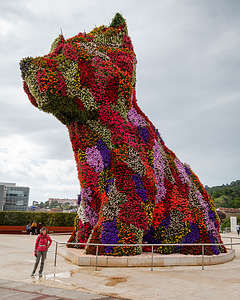 Koons' "Puppy"When we entered the museum, we found ourselves in an incredible 45-meter-high Atrium, with curved volumes and large glass curtain walls connecting the inside and the outside. There were no straight lines to be found here, which is one of the signature traits of Gehry’s architectural design. The three levels of the building, and its 20 galleries, are organized around the Atrium and connected via curved walkways, staircases, and titanium and glass elevators.
Koons' "Puppy"When we entered the museum, we found ourselves in an incredible 45-meter-high Atrium, with curved volumes and large glass curtain walls connecting the inside and the outside. There were no straight lines to be found here, which is one of the signature traits of Gehry’s architectural design. The three levels of the building, and its 20 galleries, are organized around the Atrium and connected via curved walkways, staircases, and titanium and glass elevators.
We took the elevator to the third floor, so that we could start at the top galleries and wander back down. I have to say though that as impressed and awed as we were by the architecture - both inside and out - we were not so much by the actual works of art, with some exceptions, on display. In fact, one of the criticisms of this museum is that the architectural structure overwhelms its function as a place to display artwork. People come to see that more than its contents. In any case, it is an amazing experience to wander through.
One of my favorite artworks in the museum is Jeff Koons’ “Tulips,” a gigantic stainless steel bouquet of colorful flowers located on a terrace off the atrium that overlooks the river. The flowers are over 2 meters tall and 5 meters across. The reflections of the museum and its visitors in its shiny surface create a very interesting funhouse mirror effect.
 Pintxos (tapas) in the Plaza NuevaKoons has another piece outside the main entrance to the museum named “Puppy.” It’s 42-foot-tall, highland terrier, made from over 60,000 plants and flowers that grow through a steel mesh framework. Puppy was supposed to be a temporary visitor, but the people of Bilbao fell in love with it and bought it. I, for one, am glad they did.
Pintxos (tapas) in the Plaza NuevaKoons has another piece outside the main entrance to the museum named “Puppy.” It’s 42-foot-tall, highland terrier, made from over 60,000 plants and flowers that grow through a steel mesh framework. Puppy was supposed to be a temporary visitor, but the people of Bilbao fell in love with it and bought it. I, for one, am glad they did.
We crossed the River Nervión on the Puente La Salve and walked north a bit for what turned out to be the best views of the exterior of the Guggenheim. On this side of the river, there was much more graffiti - some just artistic expressions, but others of a more political nature. Apparently, the Basque country, also had activists in a separatist movement from the rest of Spain (similar to what we had seen in Barcelona). "We are not Spain!" was painted on many a wall.
 Lolo enjoying her birthday cafe con helado (ice cream)We continued on towards the Casco Viejo, Bilbao’s old city. That is definitely something European cities have that we don’t in the states - “casco viejos,” or old towns. The U.S. simply isn’t old enough. And, my favorite places in each of the casco viejos we have visited are the plazas, where families and friends come to gather in the evenings, especially on Friday evenings, as this was.
Lolo enjoying her birthday cafe con helado (ice cream)We continued on towards the Casco Viejo, Bilbao’s old city. That is definitely something European cities have that we don’t in the states - “casco viejos,” or old towns. The U.S. simply isn’t old enough. And, my favorite places in each of the casco viejos we have visited are the plazas, where families and friends come to gather in the evenings, especially on Friday evenings, as this was.
Herb and I grabbed a table alongside the Plaza Nueva, and ordered some tapas (called pintxos in Basque country) in a local bar. It was a great place to people watch. Kids from age 5 to probably 15 were playing soccer in the square. Every kid in Spain seems to always be carrying a soccer ball. The people at the table next to us took out little books that looked like hymn books and starting singing in Basque. It was pretty magical.
Although we tried to blend in, somehow I think everyone knew we were Americans - not sure I exactly know why, and not sure I want to. After dinner, I went to pose for a picture on the square, and as I did so, a young boy probably no older than 7, said in not great, but understandable English, “Can you please move, you are in our goal.” Oops. How did he know I was an American. Perhaps it was because I was oblivious to the fact that I was standing in their goal posts.
Before heading back to the bus stop, I stopped at a cafe to have what has become one of my favorite drinks of the trip - cafe con helado (ice cream) with lots of whip cream on top. It was my birthday, so I deserved it.
Description
Once an industrial wasteland of gritty factories and shipyards, the city of Bilbao has been transformed into an international art and tourist destination. It is one of the great treasures of Spain’s Basque Country, a region that often considers itself separate from Spain and even has its own language.
Guggenheim Museum
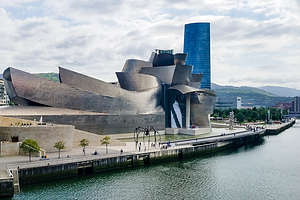 Bilbao Guggenheim MuseumFor most visitors, the Guggenheim Museum is the main draw, and it has played a major role in lifting Bilbao out of its postindustrial depression.
Bilbao Guggenheim MuseumFor most visitors, the Guggenheim Museum is the main draw, and it has played a major role in lifting Bilbao out of its postindustrial depression.
Designed by Canadian-American architect Frank Gehry and opened in 1997, this museum of modern and contemporary art is one of modern architecture’s most iconic buildings, with its gleaming titanium tiles that sheathe the exterior like giant herring scales, reflecting the colors that light projects onto it.
Critics have said that the structure overwhelms function in that it is most famous and loved for its architecture rather than the art contained within it, which is considered no better than other art museums in Europe.
As you enter the Museum, you enter the 45-meter-high Atrium, with curved volumes and large glass curtain walls connecting the inside and the outside. There are no straight lines to be found here, one of the signature traits of Gehry’s architectural design. The three levels of the building are organized around the Atrium and connected via curved walkways, staircases, and titanium and glass elevators. The Atrium functions as an axis for the museum’s 20 galleries.
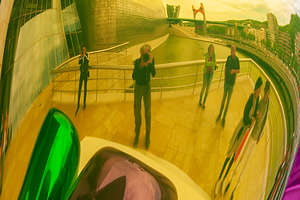 More "Tulip" reflectionsOther artists have added their touch to this amazing museum. Outside on the terrace along the riverbank lives Maman (“Mommy”), a 30-foot spider by French-American artist Louise Bourgeois.
More "Tulip" reflectionsOther artists have added their touch to this amazing museum. Outside on the terrace along the riverbank lives Maman (“Mommy”), a 30-foot spider by French-American artist Louise Bourgeois.
Guarding the main entrance is Jeff Koons’ 42-foot-tall, highland terrier “Puppy,” made from over 60,000 plants and flowers that grow through a steel mesh framework. Although originally intended to be temporary, the people of Bilbao fell in love with it and bought it.
Another piece by Koons is Tulips, a colorful stainless steel giant bouquet of seven tulips located on a terrace off the atrium overlooking the river. The flowers are huge - more than 2 meters tall and 5 meters across. The reflections of the museum and its visitors in its shiny surface create a fun house mirror effect.
The museum is open from 10 am - 8 pm every day but Monday.
Casco Viejo (Old Town)
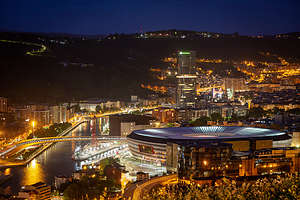 View of Bilbao from the back of our camperSouth of the Guggenheim Museum on the other side of the Ria de Bilbao is the city’s old quarter, with its tight labyrinth of charming old stone lanes, a 14th-century Gothic Cathedral, the 19th century Plaza Nueva, and boisterous tapas (called pintxos here) bars.
View of Bilbao from the back of our camperSouth of the Guggenheim Museum on the other side of the Ria de Bilbao is the city’s old quarter, with its tight labyrinth of charming old stone lanes, a 14th-century Gothic Cathedral, the 19th century Plaza Nueva, and boisterous tapas (called pintxos here) bars.
Camping in Bilbao
While there are no official commercial campgrounds in Bilbao, there is an aire (place for campers to park overnight) in the city. It is called Area de Autocaravanas de Kobetamendi, and it is located atop a hill with panoramic view of Bilbao. It costs 15€ per night and includes electricity and WiFi. A bus stop into the city is located a short distance down the hill.
- ‹ previous
- 14 of 20
- next ›
Bilbao location map in "high definition"
Javascript is required to view this map.
